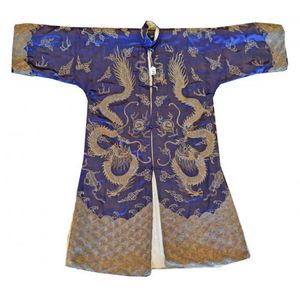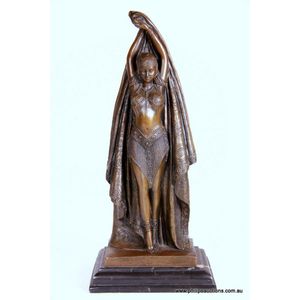Art Deco Polar Bear Bookends
You must be a subscriber, and be logged in to view price and dealer details.
Subscribe Now to view actual auction price for this item
When you subscribe, you have the option of setting the currency in which to display prices to $Au, $US, $NZ or Stg.
- Bronze - An alloy of copper and tin, traditionally in the proportions of about 9 parts of copper to 1 part of tin.
The discovery of bronze in Western Asia in the 4th century enabled people to create metal objects which were superior to those previoulsy possible because of its strength and hardness, and it has been used throughout the world for weapons, coins, tools, statuary and other decorative items.
It is very fluid in a molten state, and its hardness, strength when set, and non-corrosive properties makes it most suitable for casting sculpture. - Art Deco Period - The Art Deco period was a cultural movement that emerged in the 1920s and 1930s, and was characterized by its emphasis on modernism, luxury, and elegance. The name "Art Deco" comes from the Exposition Internationale des Arts Décoratifs et Industriels Modernes, a large exhibition held in Paris in 1925 that showcased the latest trends in decorative arts.
Art Deco was a reaction against the ornate and elaborate styles of the previous era, and reflected a new modern sensibility. It was characterized by streamlined, geometric shapes, bright colours, and the use of new materials such as chrome, glass, and Bakelite. Art Deco designers sought to create a sense of luxury and sophistication, often incorporating expensive materials such as ivory, marble, and rare woods.
Art Deco had a significant impact on a wide range of artistic fields, including architecture, fashion, graphic design, and interior design. Some of the most iconic examples of Art Deco architecture include the Empire State Building in New York City, the Hoover Building in London, and the Palais de Chaillot in Paris.
The Art Deco period came to an end in the 1940s, as World War II and changing cultural trends led to a shift in artistic styles. However, Art Deco remains an important influence on design and art, and continues to be celebrated for its modernist sensibility and glamorous aesthetic.
This item has been included into following indexes:
Visually similar items

An antique Chinese silk robe late 19th / early 20th century decorated in silver/metal wire depicting four claw mythical dragons, height 100 cm, width

An Art Deco bronze exotic dancer, after Demetre Chiparus (1886-1947), a later casting of a 1920s model of a dancer in orientalist attire with a beaded girdle and a decorative cloche, raised on her toes with a patterned cape falling from her clasped hands,

A French bronze female figurine, in burnished bronze, depicting young seated woman in a draped dress casually brushing the ground with her right hand, raised on a grey marble base, height 20 cm, width 20 cm, depth 15.5 cm

Large Khmer 12/13th century red sandstone bas-relief, of rectangular form, carved with part torso of a deity, standing with hand on hip, beside a acanthus scroll, raised on a metal stand, 49 cm x 42 cm
